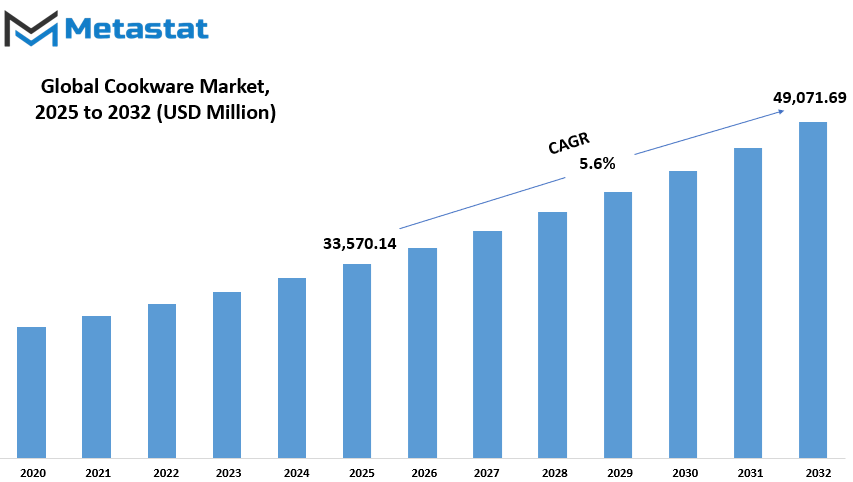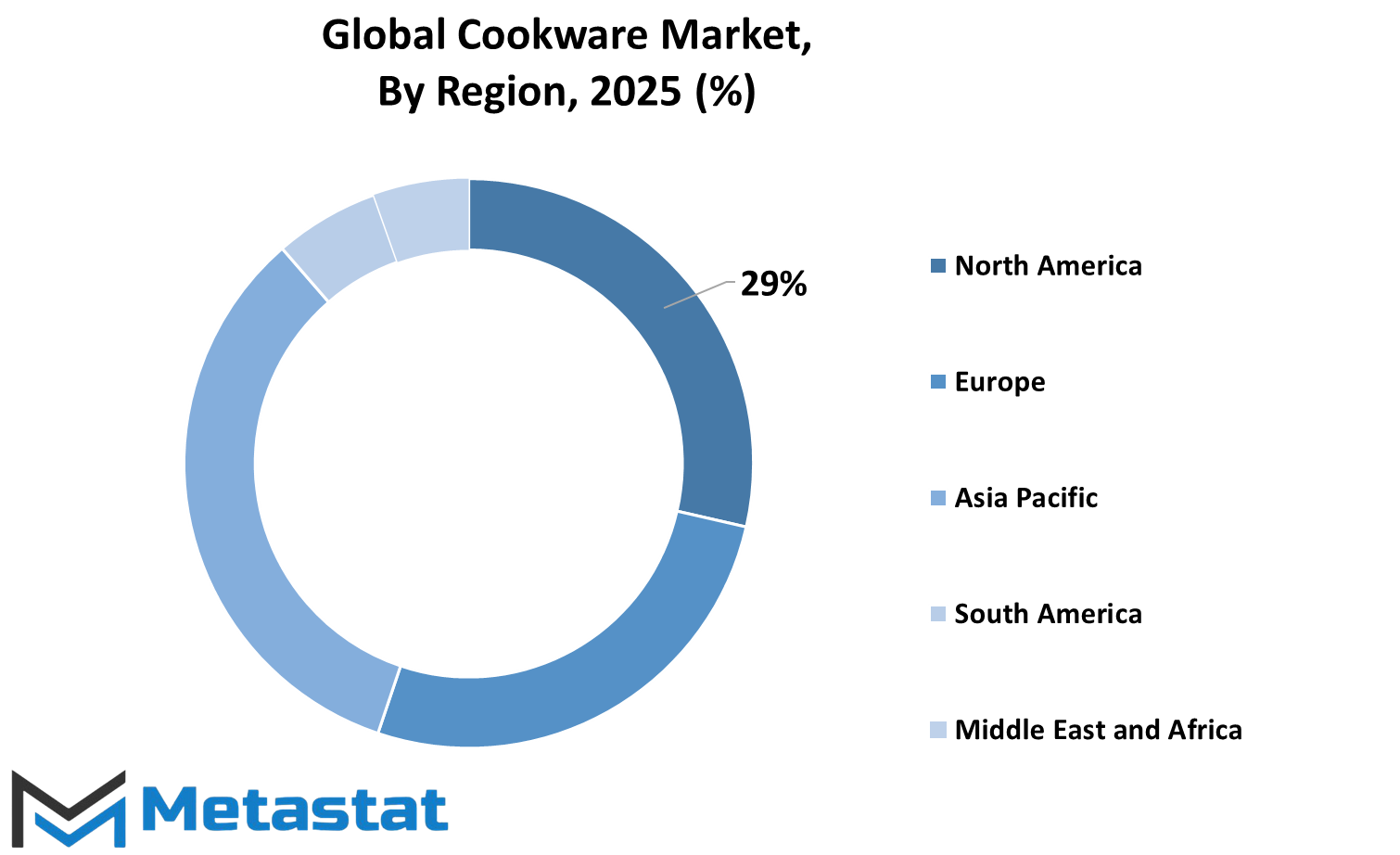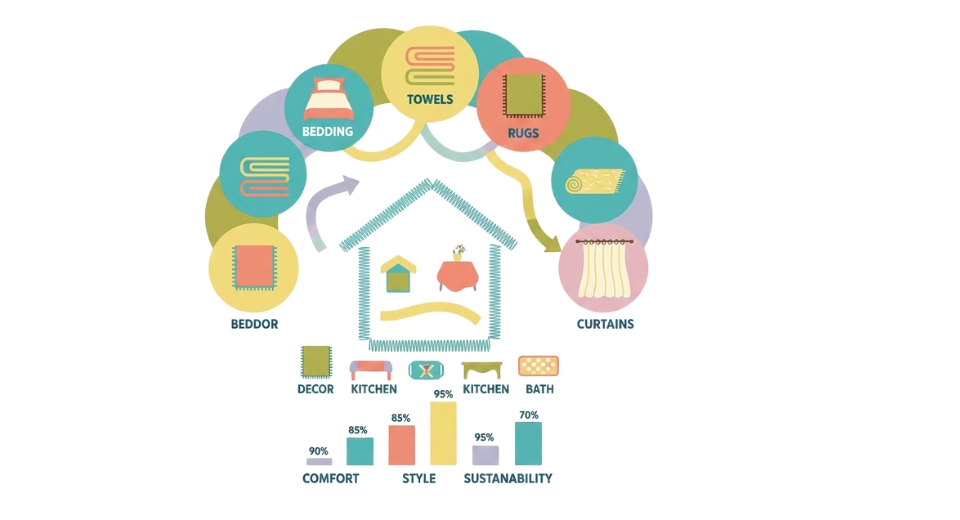MARKET OVERVIEW
The Global Cookware market and industry is considered one of the most dynamic industries to meet the essential needs of households, commercial kitchens, and the hospitality sector in general worldwide. It comprises a wide array of products created to cook, bake, or even prepare food and has satisfied different tastes and cooking demands of the consumer. The Global Cookware market is long in materials, design, and functionality. This would ensure that the product reaches all varieties of users; from an amateur home cook to a professional chef.
The force that drives this industry is the insatiable need for superior long-lasting innovative solutions in cookware. Its portfolio includes stainless steel, aluminum, cast iron, ceramic, and non-stick coatings. All these serve specific purposes according to the form of cooking intended. Though stainless steel is highly valued for its durability and resistance to corrosion, the non-stick surface just makes cooking easier, and cleaning easier, too. The variety of material has enabled producers to meet various consumer needs either in terms of performance, economy, or green sustainability.
The global cookware market is flexible with regional preferences and cooking habits. This will differ, depending on places, as lifestyle factors vary globally. Cultural cuisine, sources for fuel, etc., determine one's food preparedness in general. Asian markets are full of woks, but Dutch ovens fill the hearts of Western households and their kitchens. Due to this diversity in consumer demand, companies innovate and diversify their product lines. The product is made out of many different materials. So, with old and new mode of cooking, all sorts of cookware products are available nowadays.
The development in technology is going to provide continuous growth in the market. Smart cookware would dominate the scene: temperature control, connectivity, and energy efficiency for those consumers who will be growing up to become techno-savvy. Sustainability practices will be of prime importance too: focus will be laid upon eco-friendly materials and processes for manufacturing due to growing environmental awareness. Such inventions would not only provide functionality to cookware but also prove appealing to a consumer base that is now becoming increasingly conscious of its planet impact.
The Global Cookware market is also poised to experience dramatic growth in its delivery and distribution channels. The e-commerce websites are expected to be very crucial so that customers would have easy access to so many products from global to local brands. The traditional retail outlets will remain relevant and crucial in so many areas where most people prefer buying from a retail outlet. Other channels will be when cookware companies partner with chefs or influencers on the social media.
The Global Cookware market, as such, represents a vibrant and dynamic industry catering to the varied needs of individuals and businesses around the world. Be it in terms of material variety or diverse designs, the market will always adjust to consumer needs and maintain advances in technology and sustainability. So, based on the future focus that aims at enhancing cooking experiences made accessible to everyone, this industry goes places.
Global Cookware market is estimated to reach $49,071.69 Million by 2032; growing at a CAGR of 5.6% from 2025 to 2032.

GROWTH FACTORS
There are many drivers that are pushing the market steadily upward for Global Cookware market. However, in respect of these factors, one very important driver has been increasing demand for high-quality cookware which lasts for long. In addition, nowadays people have become very much aware about what their kitchen products are composed of and prefer only non-toxic, eco-friendly, and durable cookware. This trend further affirms increased interest in home cooking, which has become more popular with lifestyle changes and health-conscious living. As people spend more time within the kitchen, there is a greater need for a range of cookware options from traditional pots and pans to specialized kitchen utensils.
The foremost growth factor of the Global Cookware market is the need for quality, followed by rapid advancement in technology. Ceramic, stainless steel, and non-stick coatings on different materials make cooking easier and more efficient. These technologies not only make one's experience of cooking better but also ensure faster results are obtained with better food preparation. In addition, cookware companies are constantly developing products that not only save energy but also help the environment. This is because consumers have become more conscious about environmental issues and are willing to invest in both functional and environmentally friendly products.
Despite all the growth drivers still, the Global Cookware market faces several challenges, one of which is the increase in the cost of raw materials. Some of the factors that manufacturers and therefore manufacturers in the cookware industry will face include the high cost of production due to the cost of such essential metals used as well as other elements. This affects the price, and the outcome is that products might be very expensive for some clients. The cookware market will also face competitors, especially when the low-priced options are obtained from emerging economies. Such factors may prove to be a dampener for growth, mainly for sensitive price seekers.
But this market shall unlock fresh opportunities during the next years ahead. E-commerce and online shopping is growing to a great extent, and in the coming years, huge growth is pretty much possible. This fact can be seen because people order cookware on online shopping websites as well because online shopping seems easy and price attractive.
There's this trend going by the term of a smart kitchen whereby technology goes about in common, everyday ways that people take towards cooking; with cookware innovations along these trends of smart kitchen concepts and the adaptability of cooks for high-tech yet ecofriendly product types at not extremely high price values, they stand to exploit opportunity for expansions of global cookware. These changes will most likely determine the direction of this market in the future as markets change, therefore making it exciting to observe in the following years.
MARKET SEGMENTATION
By Type
The Global Cookware market has been growing steadily, driven by the increasing demand for cooking products that make meal preparation easier, more efficient, and enjoyable. People are spending more time at home, especially in light of recent global events, which is very noticeable for an interest and investment in cookware. A large portion of this market growth is attributed to the variety of cookware types available, each catering to different cooking needs and preferences. The market is highly segmented by different product types, with one of the key distinctions being the division into standard/non-coated and non-stick/coated cookware.
Non-stick or coated cookware has received particular attention due to its convenience. The non-stick properties ensure ease in the release of food while maintaining cooking by a minimal amount of oil and fat. Also, it makes cleaning much easier since food residues do not stick to the surface. This type of cookware has gained popularity among households which want a healthier mode of cooking without compromising on taste or flavor. Generally, non-stick coating is made from tough materials such as PTFE and ceramic, all of which have a great resistance to high temperatures.
The most preferred product, though, is the standard or non-coated cookware. It does not have those benefits of having a non-stick surface; however it is normally used frequently because of the durability and reliability in various ways of cooking techniques used. The most widely used materials are cast iron, stainless steel, and aluminum. Such materials are considered the best for the retention of heat and an even surface cooked which, for example, are necessary in all recipes requiring the searing of meat or the making of sauces.
Going forward, more innovation in the Global Cookware market is inevitable because manufacturers are coming up with new materials, coatings, and designs for this market based on changing consumer demands. However, the demand for both categories of cookware will be maintained; it will only be a matter of the increasing awareness about health-conscious cooking propelling the non-stick or coated category further into prominence. This can also determine the making of such cookware products globally toward sustainability. This can also include the kind of coatings used in them without harmful chemicals.
This will extend much further with the increased usage of non-stick or coated cookware. The demand for ease, simplicity, and healthiness in cooking is gradually increasing, and manufacturers will move on to preparing more efficient, durable, and sustainable products meeting the requirements of the numerous consumers of all ages. As such, cookware will remain a relevant market that will be responsive to trends in future cooking.
By Product
The global cookware market is expanding rapidly because of the increasing importance of cooking in everyday life. Changes in the cookware market in the future will be influenced by shifts in technology, changes in consumer preference, and innovation in the manufacturing process. Various products contribute to this growth, and the contribution of each category must be understood as the market continues to expand.
Pots and pans will be a constant around the globe, in kitchens, of course. Years from now, there will emerge more robust, heat-friendly, and easy-to-clean material and design types. Probably, the nonstick coatings and the induction-friendly designs of this popular series might become more enhanced so cooks can prepare more meals faster and within the shortest possible time. The push for eco-friendly materials will pick up because customers are become increasingly aware of issues of sustainability and reduced environmental footprint.
Pressure cookers have already obtained much popularity, and this trend is going to escalate further. There are people dwelling in busy families who do not have more time to consume. They seek faster cooking modes. Pressure cookers allow them to cook meals in less time while retaining their nutrients and flavors. Going forward, smart pressure cookers with technology shall be seen with ease for smoother cooking. Consumers will experience much more connectivity through the use of a smart device, voice control, and automated cooking settings, and this process is less convenient.
Cooking racks and tools are critical improvements in the efficiency of the cooking process. Racks are used for steaming, grilling, or baking, while different cooking tools that include spatulas, ladles, and tongs are used to maintain food safely and easily. Cookware in the global market will always have diverse ranges of racks and tools that differ in sizes and material as a need to consumers is constant. Innovations in new ways of cooking like air frying and sous vide are emerging. Racks and tools innovations will continue with that.
Bakeware will also be a market gaining momentum, since the interest in the home baking increases. Baking sheets and cake pans, as well as muffin trays and rolling pins, should be updated with technology that has been developed lately. Its strength and efficiency would be increased through non-stick coatings, better heat distribution, and eco-friendly materials. The people trying baking at home will be increased, thus the demand for quality bakeware also will increase.
The global cookware market is a result of customer demands toward greater efficiency, innovative products, and sustainability. This is especially where each product category from pots to bakeware comes in, for cookware has really exciting progress towards the kitchens of the future.
By Material
Cookware forms the main part of the kitchenware industry. Growth factors in it include increased consumer interest in home cooking, lifestyle changes, and technological innovations. The increase in demand for kitchen tools is also rising the demand in the global cookware market. The kind of cookware used by people is also an influence on the market. However, the type of material used in the manufacture of these items also determines the performance, durability, and price of the cookware. Looking into the future, there would be an increased demand for specific materials that should serve both functional and aesthetic purposes.
The cookware market can be segmented based on material, offering a variety of options to the consumer. Today, stainless steel is possibly the most widely used material in cookware. Long-lasting and resistant to rust, it has recently become one of the favorites in the production of pots, pans, and other basic kitchen essentials. This will, in the future, lead to a continued dominance in stainless steel cookware as it tolerates wear very well and becomes, in the best of circumstances, something that lasts a long time in the consumer's hands.
Carbon steel is more popular among professionals since it heats up efficiently and remains retained. Similar to cast iron, carbon steel conducts and retains heat very well, so this makes it better suited for professional use. However, carbon steel does need seasonings to ensure non-stick properties as well as avoid rusting. In the future, this may change due to improvements in coatings and design to be even more convenient and user-friendly.
Cast iron is a classic form of cookware. It has a great affinity for retaining heat, which makes it good for slow cooking and frying. Cast iron exudes a charm that cannot be denied, yet it is cumbersome and hard to maintain. With time, more innovative designs that reduce the weight of cast iron while preserving its heat retention properties may appear, making this product more affordable to a greater number of customers.
Another material used is aluminum, that is lightweight in nature and easily affordable. Generally, it can be found coated in non-stick cookware. Aluminum can become even more light and rigid with the advancement in technology. More market share may be derived from this reason as consumers pursue affordable yet durable cookware alternatives.
Glass cookware is less common, but it is chosen for its non-reactive nature, which does not change the flavor of food. It is also easy to clean. In the future, the demand for glass cookware may increase as people look for healthier and safer materials to cook with.
The stoneware is another variant with the merits of retaining heat to cook well, which results in uniformity while cooking food. It tends to be heavy; however, due to excellent results, this still remains the favourite of most consumers. If one can work stoneware up to achieve many versatility designs, there is likely more to the demand for the future.
With different materials in use in the cookware market, each offering some kind of unique advantage, consumer preferences will only continue to shift, and thus manufacturers will find ways to create new products for the different types of cooking habits. The cookware market around the world will probably experience increased diversity in materials used and technological upgrades that offer improved, more efficient cooking experiences.
By Distribution Channel
Noted through the years by remarkable growth trends, the changing consumer habits as well as with the advancement in technology and changing awareness of its consumers regarding more safety and ease in the operation of the kitchens, the outlook for the next few years within the cookware industry will largely be determined. The most important point to be analyzed in this market is the channels of distribution, which take cookware products to the end user. These are Supermarkets/Hypermarkets, Specialty Stores, Online platforms, and others.
Supermarkets and hypermarkets have been the most sought-after destinations for consumers to buy cookware. Retail giants like these offer convenience, a wide range of products, and competitive prices, making them the most preferred destination for consumers. With the continuously expanding global Cookware market, such stores will most likely continue to be important because they can provide a vast variety of products within the outlet. While the physical presence of supermarkets and hypermarkets will still be relevant, a shift toward digital integration within the stores will enable the entities to reach a wider number of customers – through online shopping as well as in-store experiences.
Specialty stores, specialized in specific types of products and, more importantly, focusing on better-quality cookware, will have an increasingly crucial role. There will be better personalized shopping to seek advice from expert sources and goods to fit the demands of the shoppers. As a consumer becomes keener on what the materials used in cookware are and who the craftsmen are, this is where demand for specialty retailers increases. These specialty stores will provide the higher-end cookware brands, which attract customers seeking high-quality and durability. Specialty stores will expand both in physical channels and online in the future to attract a wider range of consumers.
Online is expected to be the fastest-growing distribution channel in the global Cookware market. With the boom in e-commerce, consumers now prefer to purchase cookware from online stores, as it’s convenient, people can read reviews, and many times, it’s cheaper. It has been further encouraged by the spread of the COVID-19 virus, as there is a great need for customers to shop more online for all their daily necessities. The online part of the cookware market is expected to expand even more in the coming years with the growth of digital platforms, better delivery systems, and a more customized customer experience.
The other channels for distribution include direct sales by the manufacturers or third-party platforms. However, these are likely to be smaller contributors than supermarkets, specialty stores, and online platforms, which are increasingly growing.
The distribution channels will be shaped by a more connected and convenience-driven world as the Global Cookware market progresses. In the future, the market for cookware will be shaped by the shift toward online shopping and the continued presence of physical stores, offering consumers more options and enhancing the overall shopping experience.
|
Forecast Period |
2025-2032 |
|
Market Size in 2025 |
$33,570.14 million |
|
Market Size by 2032 |
$49,071.69 Million |
|
Growth Rate from 2024 to 2031 |
5.6% |
|
Base Year |
2024 |
|
Regions Covered |
North America, Europe, Asia-Pacific, South America, Middle East & Africa |
REGIONAL ANALYSIS
The global cookware market is becoming increasingly diversified and expanding across different regions, each with its unique characteristics and consumer behavior. As the global demand for cookware continues to grow, it's crucial to understand what drives demand for this type of product in different areas. North America, Europe, Asia-Pacific, South America, and the Middle East & Africa will all shape the future face of the cookware industry.
In North America, the market for cookware will continue to grow steadily because of increased interest in home cooking and with the rising culinary tourism trend. The U.S. market is expected to exhibit strong growth, with traditionalist fans of cookware and an increasingly growing health-conscious cooking trend fueling it. The popularity of cooking shows, celebrity chefs, and social media platforms fostering home cooking will continue to fuel this market's growth. Canada and Mexico will also be experiencing growth, though the demand may not be as high as in the U.S., due to different cultural and economic factors. Demand for cookware will be at an all-time high in Europe, representing countries like the UK, Germany, France, and Italy.
The European market will expand further with sustainability and innovation becoming important to the consumer. Eco-friendly materials for cookware and healthy cooking methods will receive more attention. France and Italy, with their culinary heritage, are major players in cookware; the emphasis is placed here on high-quality, durable goods. The rest of Europe would also contribute to this market, though consumer preferences are going to differ based on the economic conditions and lifestyle choices.
In the Asia-Pacific region, countries like China, India, Japan, and South Korea will form the core contributor to the global cookware market. As population increases, demand for cooking products increases, mainly in urban centres, where only a growing middle class is adding new consumer segments.
India and China are likely to be extremely high-growth demand areas in cookware with an emerging population and massive urbanization. Japan and South Korea are going to be very increasing in advanced cookware because culture there is a complete example of accepting innovation in their life at every level of day-to-day living. The other part of Asia-Pacific will grow as well-for instance, Indonesia and Thailand are very likely to represent expansion in those markets. In South America, Brazil and Argentina are expected to lead the market. As these economies recover and consumer confidence grows, demand for cookware will rise, particularly in the urban centers.
A slowdown and some growth from the rest of South America at a slower place than in their larger markets at home in Brazil and Argentina. The Middle East & Africa - demand will continue to vary regionally. Overall, there would be growth because of an ever-increasing and increasing trend to modern cooking solutions in the GCC.
Egypt and South Africa will contribute to regional demand, and South Africa will particularly see steady increases in interest for both local and international cookware brands. All other parts of the Middle East & Africa will have mixed demand levels where one country will prefer luxury as opposed to the others that will be looking for affordability and practicality. In conclusion, the global market for cookware will continue to take shape with contributions from each unique region.
Other trends such as urbanization and sustainability and also health-conscious food preparation will eventually shape the nature of this particular market, while differences in regional needs and economic climates will dictate certain demand in local markets. A dynamic global market for cookware will be built on the local drivers of its growth.

COMPETITIVE PLAYERS
The global market for cookware has experienced significant growth in the past few years with so many people investing in quality kitchen products. With cooking at the center stage in almost every home, it has become an essential tool for professionals and home chefs alike. Demand increases are driven by the interest in home cooking but also through continued innovation in materials, designs, and cookware technologies. Future competition will grow in the cookware industry, where major players compete for leadership.
Some other influential businesses within the global cookware market are All-Clad Metalcrafters, LLC, Meyer Corporation, and Tefal (Groupe SEB). These market giants have already established themselves as strong distributors of non-carbon steel and stainless steel cookware that proves to be worthy and reliable among professional chefs and individual home cooks alike. Moreover, because they adapt well to the needs of consumers, which is to continually keep introducing new features in the product and changes in the look, they will continue retaining their leadership positions in the market.
In addition to these large players, there are many other companies working hard to find their niche in this competitive market. Le Creuset, Zwilling J.A. Henckels, and Calphalon (Newell Brands) to name a few. They come with innovative cookware options yet still identify themselves as being part of those specific brands. These companies are aware of the demand for sustainable and eco-friendly products, which led to the emergence of new materials, such as ceramic, non-stick coatings, and recycled metals. It is likely that changes in materials and manufacturing processes will become more visible as sustainability will be an increasingly important factor in consumer decisions in the coming years.
Lodge Manufacturing Company, Cuisinart (Conair Corporation), and Target are also expected to play an important role in meeting the diverse needs of consumers. Their focus on providing affordable, accessible cookware options while maintaining a balance of quality and value will allow them to compete with larger players in the market. As the industry advances, e-commerce sites and online selling will be much more in use, where easy access to a vast number of cookware products would be available for the consumer.
Other prominent brands like Scanpan, TTK Prestige Ltd, and The Vollrath Co., L.L.C. will continue to focus on creating new and better solutions for cookware for growing market demands within the industry. As technology grows in the kitchen, the increasing investment will be in smart cookware from brands like KitchenAid (Whirlpool Corporation), Fissler GmbH, and WMF Group so that consumers can have a hassle-free and convenient experience while cooking.
Competition will drive the future of the global cookware market, wherein technological innovations, consumer demands, and sustainability concerns will mingle in order to constitute a single outcome for any brand's success. Any brand that is able to predict and react to these changes will be able to have products that fit today's consumers and are durable enough to be continued.
Cookware Market Key Segments:
By Type
- Standard /Non-Coated
- Non-Stick/ Coated
By Product
- Pots & Pans
- Pressure Cooker
- Cooking Racks
- Cooking Tools
- Bakeware
- Others
By Material
- Stainless Steel
- Carbon Steel
- Cast Iron
- Aluminum
- Glass
- Stoneware
- Others
By Distribution Channel
- Supermarket/ Hypermarket
- Specialty Stores
- Online
- Others
Key Global Cookware Industry Players
- All-Clad Metalcrafters, LLC
- Meyer Corporation
- Tefal (Groupe SEB)
- Le Creuset
- Zwilling J.A. Henckels
- Calphalon (Newell Brands)
- Lodge Manufacturing Company
- Cuisinart (Conair Corporation)
- Scanpan
- Target
- TTK Prestige Ltd
- The Vollrath Co., L.L.C.
- Mauviel 1830
- Hawkins Cookers Limited.
- KitchenAid (Whirlpool Corporation)
- Fissler GmbH
- WMF Group
- Viking Range, LLC
- GreenPan
- Pyrex (Corning Incorporated)
- La Cornue
- Scanpan
- Hestan Culinary
WHAT REPORT PROVIDES
- Full in-depth analysis of the parent Industry
- Important changes in market and its dynamics
- Segmentation details of the market
- Former, on-going, and projected market analysis in terms of volume and value
- Assessment of niche industry developments
- Market share analysis
- Key strategies of major players
- Emerging segments and regional growth potential








 US: +1 3023308252
US: +1 3023308252






